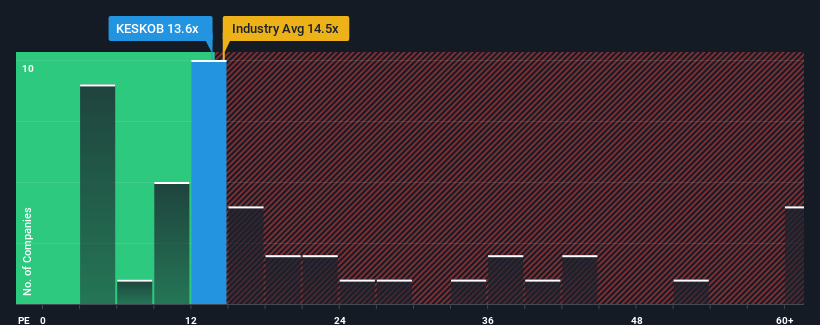- Finland
- /
- Food and Staples Retail
- /
- HLSE:KESKOB
Kesko Oyj's (HEL:KESKOB) Shares Lagging The Market But So Is The Business

Kesko Oyj's (HEL:KESKOB) price-to-earnings (or "P/E") ratio of 13.6x might make it look like a buy right now compared to the market in Finland, where around half of the companies have P/E ratios above 18x and even P/E's above 28x are quite common. Although, it's not wise to just take the P/E at face value as there may be an explanation why it's limited.
With earnings that are retreating more than the market's of late, Kesko Oyj has been very sluggish. The P/E is probably low because investors think this poor earnings performance isn't going to improve at all. If you still like the company, you'd want its earnings trajectory to turn around before making any decisions. Or at the very least, you'd be hoping the earnings slide doesn't get any worse if your plan is to pick up some stock while it's out of favour.
See our latest analysis for Kesko Oyj

How Is Kesko Oyj's Growth Trending?
In order to justify its P/E ratio, Kesko Oyj would need to produce sluggish growth that's trailing the market.
Retrospectively, the last year delivered a frustrating 19% decrease to the company's bottom line. This has soured the latest three-year period, which nevertheless managed to deliver a decent 14% overall rise in EPS. Although it's been a bumpy ride, it's still fair to say the earnings growth recently has been mostly respectable for the company.
Turning to the outlook, the next three years should generate growth of 2.0% per year as estimated by the six analysts watching the company. With the market predicted to deliver 14% growth per year, the company is positioned for a weaker earnings result.
With this information, we can see why Kesko Oyj is trading at a P/E lower than the market. It seems most investors are expecting to see limited future growth and are only willing to pay a reduced amount for the stock.
The Bottom Line On Kesko Oyj's P/E
It's argued the price-to-earnings ratio is an inferior measure of value within certain industries, but it can be a powerful business sentiment indicator.
We've established that Kesko Oyj maintains its low P/E on the weakness of its forecast growth being lower than the wider market, as expected. At this stage investors feel the potential for an improvement in earnings isn't great enough to justify a higher P/E ratio. Unless these conditions improve, they will continue to form a barrier for the share price around these levels.
And what about other risks? Every company has them, and we've spotted 2 warning signs for Kesko Oyj you should know about.
Of course, you might also be able to find a better stock than Kesko Oyj. So you may wish to see this free collection of other companies that have reasonable P/E ratios and have grown earnings strongly.
If you're looking to trade Kesko Oyj, open an account with the lowest-cost platform trusted by professionals, Interactive Brokers.
With clients in over 200 countries and territories, and access to 160 markets, IBKR lets you trade stocks, options, futures, forex, bonds and funds from a single integrated account.
Enjoy no hidden fees, no account minimums, and FX conversion rates as low as 0.03%, far better than what most brokers offer.
Sponsored ContentValuation is complex, but we're here to simplify it.
Discover if Kesko Oyj might be undervalued or overvalued with our detailed analysis, featuring fair value estimates, potential risks, dividends, insider trades, and its financial condition.
Access Free AnalysisHave feedback on this article? Concerned about the content? Get in touch with us directly. Alternatively, email editorial-team (at) simplywallst.com.
This article by Simply Wall St is general in nature. We provide commentary based on historical data and analyst forecasts only using an unbiased methodology and our articles are not intended to be financial advice. It does not constitute a recommendation to buy or sell any stock, and does not take account of your objectives, or your financial situation. We aim to bring you long-term focused analysis driven by fundamental data. Note that our analysis may not factor in the latest price-sensitive company announcements or qualitative material. Simply Wall St has no position in any stocks mentioned.
About HLSE:KESKOB
Kesko Oyj
Engages in the chain operations in Finland, Sweden, Norway, Estonia, Latvia, Lithuania, Denmark, and Poland.
Adequate balance sheet and fair value.


